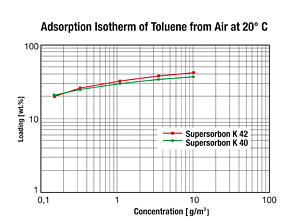Activated Carbons for Solvent Recovery
The solvent processing industry, e. g. the printing industry, dry cleaning shops and paint shops, depend on solvents which are vaporised in the course of the production process. Recovery of these solvents from the process exhaust air is desirable both from economic and ecological aspects. The principle underlying the Donau Carbon SUPERSORBON®-Solvent Recovery Process is the adsorption of solvents on activated carbon and their subsequent desorption by means of superheated steam or hot inert gas. The resulting condensate is further treated to recover the solvent for reuse in the production process.
The solvent recovery process relies on high-quality activated carbon grades with a well-balanced pore structure. While the micro-pores are crucial to solvent retention and hence, compliance with the prescribed VOC emission limits, the access pores in the macro- and meso-pore range facilitate desorption of the solvents from the activated carbon.
The activated carbon is charged in fixed-bed adsorbers and should offer as low a flow resistance as possible. This is the reason why 4mm extruded carbon pellets are the adsorbents of choice for this application. Depending on the type of solvent to be removed, activated carbon grades of different raw material origins or low-ash carbon grades are employed to give the best treatment result.
 Recommended AC Qualities:
Recommended AC Qualities:
Supersorbon K 40
Supersorbon KM
Supersorbon K 42
Further technical documents and samples available on request.